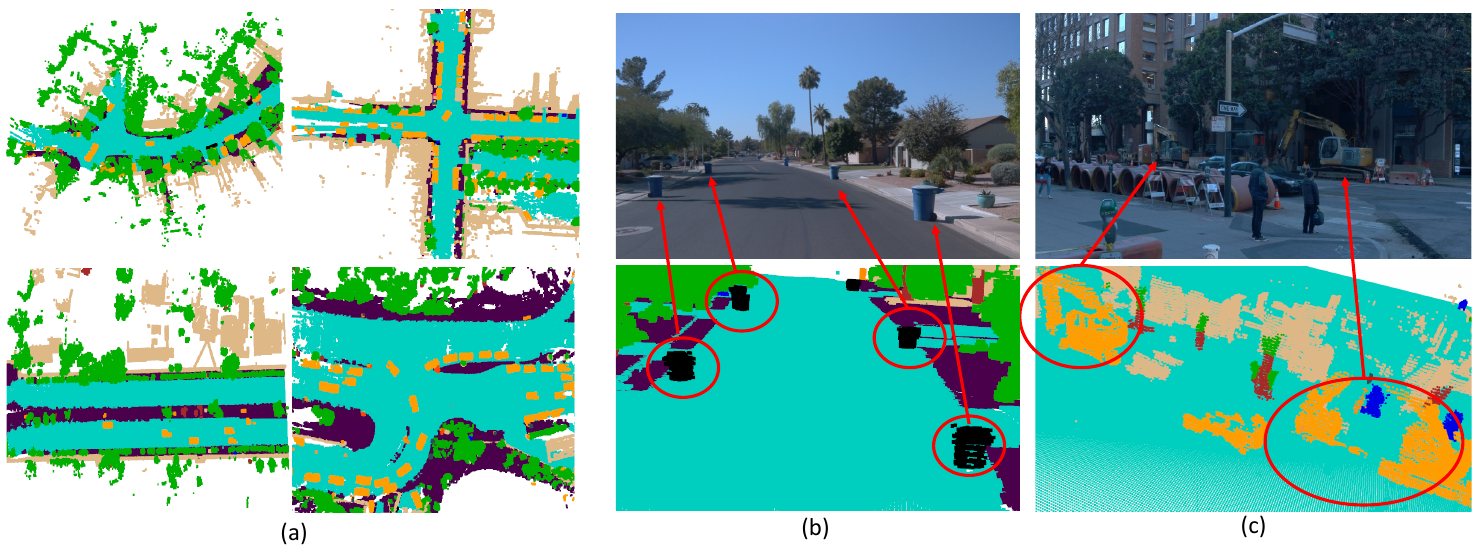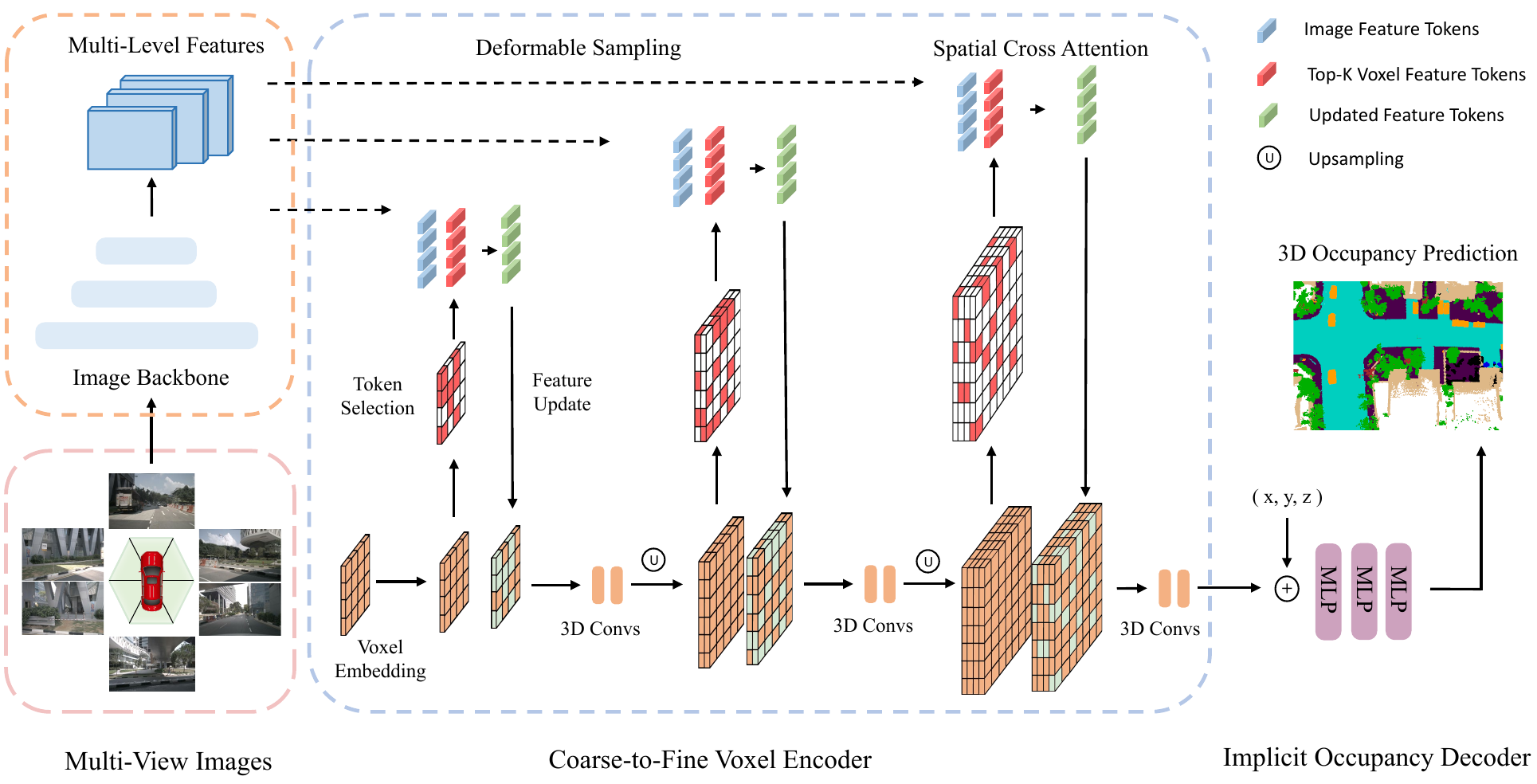Introduction
One of the most popular visual perception tasks is 3D object detection, their expressiveness is still limited as shown in Figure1: (1) 3D bounding box representation erases the geometric details of objects, eg a bendy bus or a construction vehicle; (2) rarely seen objects, like trash or tree branch on the streets, are often ignored and not label in existing datasets.

Figure 1:The Occ3D dataset demonstrates rich semantic and geometric expressiveness.
We formalize the 3D occupancy prediction task as follows: a model needs to jointly estimate the occupancy state and semantic label of every voxel in the scene from images. The occupancy state of each voxel can be categorized as free, occupied, or unobserved. For occupied voxels, semantic labels are assigned. For objects that are not in the predefined categories, they are labeled as General Objects (GOs).
CVPR2023 Occupancy Prediction Challenge
To promote the 3D occupancy prediction task, we co-host a 3D Occupancy Prediction Challenge in CVPR2023. For more information about the challenge, please refer to the Challenge Page.
The Occ3D Dataset
Dataset Downloads
We generate two 3D occupancy prediction datasets, Occ3D-Waymo and Occ3D-nuScenes. Checkout our code and toolkit to get started using our datasets. Before using the dataset, you should agree to the terms of use of the nuScenes and Waymo. The code used to generate the data and the generated data are both subject to the MIT License.

Table 1: Comparing Occ3D Datasets with other datasets for 3D perception.
Dataset Construction Pipeline
Acquiring dense voxel-level annotations for a 3D scene can be challenging and impractical. To address this, we propose a semi-automatic label generation pipeline that utilizes existing labeled 3D perception datasets.

Figure 2: Our label generation pipeline.
Our proposed label generation pipeline addresses the above challenges, an overview is shown in Figure 2. Initially, in voxel densification, we increase the density of the point clouds by performing multi-frame aggregation for both static and dynamic objects separately. Then we employ a K-nearest neighbor algorithm to assign labels to unlabeled points and utilize mesh reconstruction to perform hole-filling. Subsequently, we carry out occlusion reasoning from both LiDAR and camera perspectives, utilizing a ray-casting operation to label the occupancy state of each voxel. Finally, misaligned voxels are eliminated through an image-guided voxel refinement process.
Quality Check
Acquiring an occupancy representation that adheres to the complete shape of all objects is challenging. Therefore, evaluating the quality of the dataset and ensuring the effectiveness of each step in our pipeline is critical.

Figure 3: 3D-2D consistency.
Our proposed label generation pipeline addresses the above challenges, an overview is shown in Figure 2. Initially, in voxel densification, we increase the density of the point clouds by performing multi-frame aggregation for both static and dynamic objects separately. Then we employ a K-nearest neighbor algorithm to assign labels to unlabeled points and utilize mesh reconstruction to perform hole-filling. Subsequently, we carry out occlusion reasoning from both LiDAR and camera perspectives, utilizing a ray-casting operation to label the occupancy state of each voxel. Finally, misaligned voxels are eliminated through an image-guided voxel refinement process.
Methods
To deal with the challenging 3D occupancy prediction problem, we present a new transformer-based model named Coarse-to-Fine Occupancy (CTF-Occ). First, 2D image features are extracted from multi-view images with an image backbone. Then, 3D voxel queries aggregate 2D image features into 3D space via a cross-attention operation. Our approach involves using a pyramid voxel encoder that progressively improves voxel feature representations through incremental token selection and spatial cross-attention in a coarse-to-fine fashion. This method enhances the spatial resolution and fine-tunes the detailed geometry of objects, ultimately leading to more accurate 3D occupancy predictions.

Figure 4: The model architecture of CTF-Occ.
An overview of CTF-Occ network is shown in Figure 3. First, 2D image features are extracted from multi-view images with an image backbone. Then, 3D voxel queries aggregate 2D image features into 3D space via a cross-attention operation.
Experiments
Our method outperforms previous methods on Occ3D-Nuscenes and Occ3D-Waymo dataset.


Table 2: 3D occupancy prediction performance on the Occ3D-nuScenes and Occ3D-Waymo dataset. Cons. Veh represents construction vehicle and Dri. Sur is for driveable surface.
BibTeX
@article{tian2023occ3d,
title={Occ3D: A Large-Scale 3D Occupancy Prediction Benchmark for Autonomous Driving},
author={Tian, Xiaoyu and Jiang, Tao and Yun, Longfei and Wang, Yue and Wang, Yilun and Zhao, Hang},
journal={arXiv preprint arXiv:2304.14365},
year={2023}
}